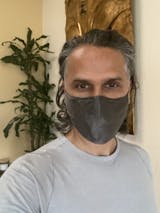What’s the difference between silk and satin? This is a common question from shoppers comparing benefits to price points on these two soft options for high end bedding and pillowcases.
Silk is an amazing material – especially if you choose to go with fully organic, sustainable silk. However, it isn’t the only option when you’re on the market for a luxurious pillowcase or bedsheet.
So let’s take a minute to explore the real differences between silk and satin, and which might be better for the goals you’re looking to accomplish with your textile choices.
What Is Silk?
Silk is a fiber produced by certain insects when they build cocoons and webs. Mulberry silk is the most popular (and also the softest) variety, which is silk created by silkworms that are fed mulberry leaves. So, silk is completely natural. It isn’t a man-made fabric, and it contains no traces of plastic.
Silk is a breathable, comfortable material with various beneficial properties that make it ideal for clothing, pillowcases, and face masks. Studies have found it to have anti-inflammatory, hypoallergenic and antimicrobial properties. This means that in addition to being natural, silk is very good for people suffering from allergies or acne.
What Is Satin?
Satin is a glossy, man-made fabric synthesized using a blend of other fabrics – including nylon, rayon, polyester, and sometimes silk. Usually, satin will have a glossy side and a dull side. It is comparable to silk in terms of feel, but only on the glossy side.
As you can see, one major downside of satin is that it is man-made and contains plastic textiles. That is problematic because every time you wash something made of satin, it will shed tiny microplastics that will make their way into our waterways and, eventually, the ocean. If one of your top goals as a consumer is to shop eco-friendly products, it is important to avoid textiles containing plastic.
Silk Vs Satin: The Difference
How is organic sustainable silk different from satin? There are some obvious differences (like the fact that satin isn’t organic or sustainable), and some not-so-obvious ones. Let’s go over some of the more important differences between the two fabrics.
Softness
Of the two, silk is definitely softer. While satin has a glossy feel and might feel like silk in terms of slipperiness on its glossy side, it is nowhere close in terms of softness. Silk is a natural fabric, and as such, is a sumptuous, soft material. In addition, the softness of silk can be measured with the unit momme. For example the Fait avec Coeur organic sustainable silk pillowcases are made with 30 momme silk, which is literally the softest silk available.
Affordability
Satin is more affordable compared to silk. This is due to it being a synthesized textile and can be mass-produced, which drives costs down. Producing silk, on the other hand, involves a lengthy, intentional process that relies in part on the environment, elements, and climate patterns. So, while you might enjoy luxuriating on a silk bedsheet, you’ll have to think of it as an investment to better your skin health and support sustainable consumerism, not just an expense.
Sustainability
Organic, sustainable silk is better than satin in a lot of ways – and one major reason is because it’s organic and sustainable! At Fait avec Coeur, we are committed to make sustainable products for you and your family. We want to honor ourselves, our earth and acknowledge the circle of life. Our silk products are made with sustainable materials, sourced responsibly, and made with heart by amazing people around the world.
We need sustainability in this era of pollution and waste, because continuing to use natural resources without thinking about the future is not an option. Silk is a perfectly sustainable fabric.
Satin, unfortunately, is neither organic nor sustainable.
Durability
Silk is a much stronger material than satin. This is important because when you’re investing in a high-quality bedsheet or pillowcase, you want it to last a long time. Being a durable, strong material, silk is much more likely to stand the test of time without tears and other damage to the structure.
Ease of cleaning
Satin is usually easier to clean than silk, because despite being a strong material, silk is very delicate and can be damaged easily. It is particularly susceptible to stains and heat damage. For best results, hand wash your silk in cold water, use gentle laundry soap. Hang to dry, do not tumble dry. If you’re careful with your silk pillowcase, it will last years while looking great.
Which Material Is Best For Sleeping On?
Now that you know some of the differences between silk and satin, let’s go over which material is better for sleeping on – and why! Both fabrics have their own unique characteristics, and these play a deciding role in this aspect.
Less absorbent - in a good way!
Both satin and silk are highly glossy, which means that its slippery surface won’t absorb your beauty product as much as cotton. When you apply a serum or hair product during your bedtime ritual, you want it to stay on your skin and work its magic overnight. You don’t want your pillowcase rubbing it off. So, go with a minimally absorbent material like silk to make sure more of your beauty product stays on your skin.
Heating/Cooling Effects
Silk is a cool fabric which heats up easily with body heat. This means that it’s both cool and warm, thus providing the best of both worlds. Satin is slightly cooler than silk, so if you like your bedsheets and pillowcase cool, you may prefer satin over silk.
Breathability
The threads of silk are very thin, which means the fabric is more breathable. It’s comparable to cotton and linen in terms of breathability. However, unlike cotton and linen, it doesn’t absorb odors. Satin too fares pretty well in terms of breathability, although silk wins by a slight margin.
Good for allergies
Silk is a hypoallergenic fabric, the meaning of which we discussed in a previous blog post. In a nutshell, it means that it is less likely to trigger your allergies. So, if you are allergic to certain fabrics and want to play it safe, go with silk. You can also try silk eye masks, clothes and other materials. Satin has no hypoallergenic properties.
Good for hair
Silk, being a slippery fabric with very little friction, helps maintain the natural oils in your hair, as well as any products you apply overnight. Satin may have similar benefits, but the tightness of the weave in satin will affect its level of friction, so it may vary from product to product.
With silk, you can be confident in low friction for your hair, as long as the fabric is organic, and above 20 momme. That’s why the Fait avec Coeur pillowcases are made from 30 momme organic silk - literally the softest fabric on earth!
Conclusion: If You’re in the Market for the Best Quality Pillowcase, the Fait avec Coeur 100% organic, 30 Momme Silk pillowcase is the Best Choice!
Fait avec Coeur is a brand that takes its mission seriously. We want to provide our customers with luxurious, sustainable products that help elevate their everyday life. When deciding what products we wanted to offer, we went over our options carefully – and we chose silk for good reasons! It has various benefits which make it the perfect material for a pillowcase.
So, while satin has its advantages (ease of cleaning and cost being two major ones), silk wins out for our mission due to its sustainable nature, and because it’s a much softer, more lovable fabric. Human-made fabrics will probably never be quite as good as what nature has to offer. Our products are made with 100% pure mulberry silk, so they are super soft. Give them a try, and you’ll feel the difference!
All of Fait avec Coeur's silk products are OEKO-TEX®, BSCI, and ISO certified.










